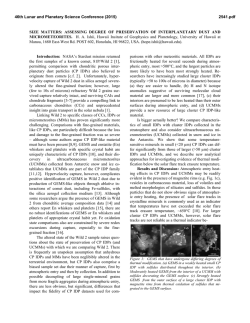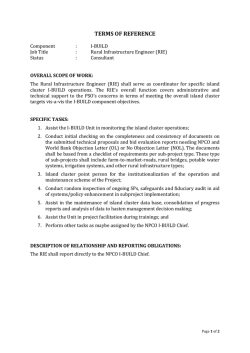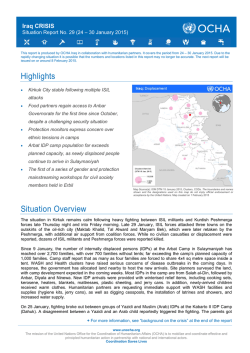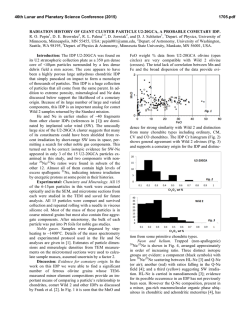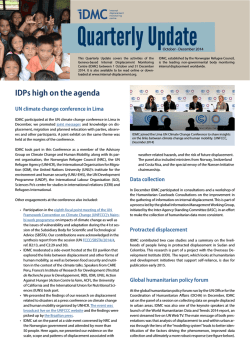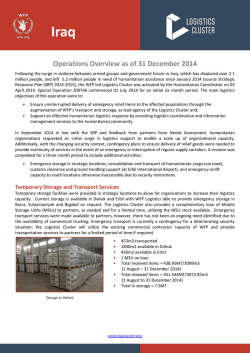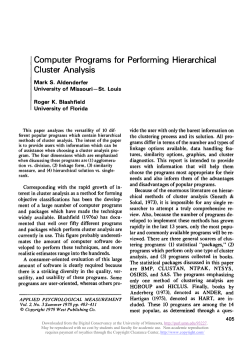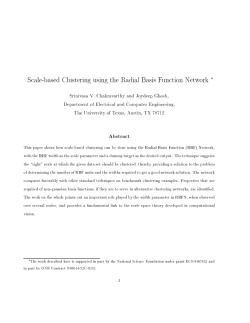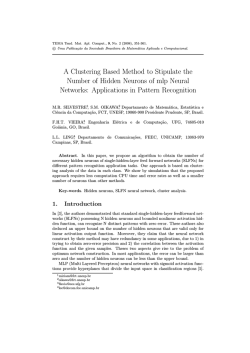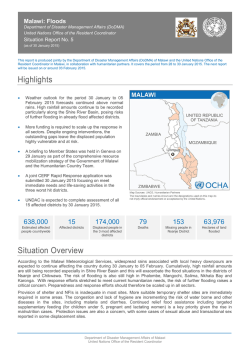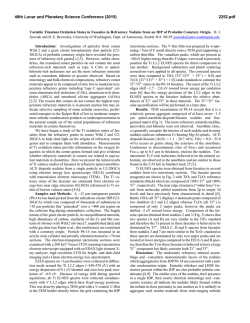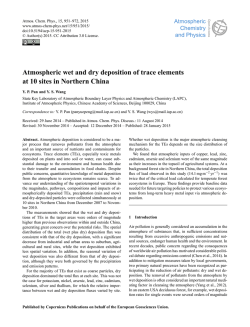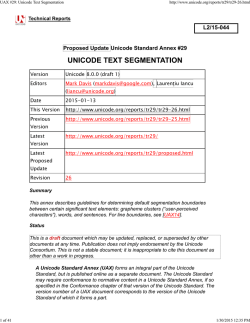
Si Mg Al P S Al Mg Si P S Ca K
46th Lunar and Planetary Science Conference (2015) 1260.pdf P, S, AND K K-EDGE X-RAY ABSORPTION NEAR-EDGE STRUCTURE (XANES) SPECTROSCOPY OF LARGE CLUSTER IDPs . G. J. Flynn1, P. Northrup2 and S. Wirick3, 1Dept. of Physics, SUNY-Plattsburgh, 101 Broad St., Plattsburgh, NY 12901 USA ([email protected]), 2Stony Brook University and NSLS-II, Brookhaven National Laboratory; Bldg. 743, Upton NY 11973, 3 CARS, University of Chicago, Chicago IL 60637 Introduction: The Tender Energy Spectroscopy (TES) beamline at the National Synchrotron Light Source II (NSLS II) is designed to fill the gap between low energy (C, N, O) spectroscopy and hard x-ray (typically elements from Ca to Pd) spectroscopy. The TES beamline at NSLS II will have a user-tunable spot size ranging from 15x25 µm, with a flux delivered to the sample up to 1012 ph/s, down to 0.75x2 µm, with a flux up to 109 ph/s. A helium glove-box sample chamber will permit X-ray fluorescence (XRF) imaging of fluorescence lines down to 800 eV, allowing quantitative abundance mapping of elements as light as Na. The monochrometer is tunable over the range 1.2 to 8 keV, optimized for K-edge x-ray absorption near-edge structure (XANES) spectroscopic analyses of Mg to Co, as well as the Ge to Ho L3 edges, and Tb to Pu M5 edges. We performed Mg, Al, Si, P, and S element mapping and S, P, and K K-edge XANES of one large, cluster interplanetary dust particle (IDP) and Mg, Al, Si, P, S, K, and Ca element mapping on a second cluster IDP using a prototype of the TES instrument, while it was under development at the National Synchrotron Light Source (NSLS) Beamline X15B. The prototype had lower x-ray flux (1010 ph/s) and an ~10 µm beamspot, but employed the same tunable monochrometer. Samples: Cluster interplanetary dust particles (IDPs) are particles large and weak enough to break apart on impact with the collector, resulting in a cluster of fragments localized on the collector surface. Two cluster IDPs, L2009R2 and L2008Z2, which had previously been analyzed in the hard x-ray microprobe on beamline X26a of the NSLS, were selected for the initial TES analysis. Both of these particles were determined to be anhydrous with Zn/Fe >1.1xCI, with these Zn contents suggesting that each experienced little atmospheric entry heating [1]. L2009R2 is unusual in that it contains a large amount of non-diffracting, amorphous, material [2]. Both of these cluster IDPs have bulk Fe-XANES spectra consistent with Fe2+ being the dominant Fe oxidation state, but neither spectrum is consistent with fayalite [3]. One 8 µm pixel in L2009R2 exhibits an Fe-XANES spectrum consistent with Fe- or Fe-Ni-metal, with the fraction of the total Fe that is present as Fe-metal being ~14 to 21%, [4]. The Cr-XANES spectrum of L2008Z2 is dominated by Cr3+, and best fit by a mixture containing about equal quantities of chromite and Cr-bearing diopside [3]. Mg Al Si Figure 1: Mg, Al, Si, P and S fluorescence maps of L2009R2 taken with a 10x10 µm beamspot. \ P S Results and Discussion: Figure 1 shows the Mg, Al, Si, P, and S element maps for L2009R2. In L2009R2 Mg is generally co-located with Si, consistent with the presence of Mg-silicates, while P and S are more localized and not correlated with Si. L2008Z2 was mapped at two energies. The first set of element maps for Mg, Al, Si, P, and S, while a second analysis at a higher beam energy allowed K and Ca maps. The full set of maps is shown in Figure 2. Unlike L2009R2, the element maps are relatively uniform in L2008Z2, except for K, which occurs at only a few hot-spots. But this could simply be a thickness effect, since L2008Z2 is more compact so each pixel may sample more diversity of grains than in L2009R2. Al Mg P S K Si Ca Figure 2: : Mg, Al, Si, P, S, Ca and K fluorescece maps of L2008Z2. 46th Lunar and Planetary Science Conference (2015) Figure 3: S-XANES spectra of three spots having different S contents on L2009R2. sulfate S-XANES Results. The S-XANES spectra of three spots on L2009R2 are shown in Figure 3. In these unnormalized spectra the increase in absorption at the S K-edge is proportional to the S abundance. The SXANES spectra are consistent with metal-sulfide accompanied by a sulfate (~2483 eV). Figure 3 shows that the sulfate contribution to the spectrum is larger as the total amount of S, indicated by the height of the absorption edge, decreases. If the total S is taken as a proxy for grain size, this result is consistent with the grains each having a sulfate reaction rim of approximately the same thickness. P-XANES Results. The most common elements in a typical cell are hydrogen, oxygen, carbon, nitrogen, phosphorus and sulfur. Of these, P is the least abundant, but it is a critical structural element in DNA and RNA. Thus, understanding the distribution and speciation of P is particularly important because of its role in biology and the origin of life. Because P is less abundant and suffers from more absorption in the sample than S, in particular being masked by the silicone oil present on the surface, the PXANES spectrum in Figure 4 is of poorer quality than Figure 4: (left) P-XANES spectrum of a spot on L2009R2, and enlargement (right) showing the absorption feature is at the phosphate, rather than the phosphide, position. 1260.pdf Figure 5: K-XANES spectrum of L2009R2. the S-XANES spectra. However, the P-XANES spectrum clearly shows the phosphate absorption feature, rather than phosphide (Figure 4, right). K-XANES: The K-XANES spectrum of L2009R2 is shown in Figure 5. Further evaluation of standards will be required to interpret the speciation of K in this sample, however it is consistent with K+ in a silicate or glass matrix. Conclusions: S-XANES on L2009R2 suggests the surfaces of the sulfides in this IDP have been altered to sulfate. Whether this reaction occurred in the Solar Nebula, on the parent body, or during atmospheric deceleration is not known. However, the high Zn content, Zn/Fe=1.9xCI [5], indicates this IDP experienced minimal alteration during atmospheric deceleration and heating would likely produce metal rather than sulfate. Phospherous is generally found as phosphates in stone meteorites while the phosphides are mainly present in iron meteorites [6]. Modeling by Pasek and Lauretta [7] suggests that reactive P, important for the development of life, would be delivered to Earth’s surface in the form of phosphide minerals. In the case of L2009R2, we find phosphate, rather than phosphide, as the dominant P speciation. However, L2009R2 is a rather atypical cluster IDP, being the only one we have examined thus far that contains Fe-metal [4]. Examination of more IDPs is required to determine the dominant P speciation in primitive IDPs. These results on two large cluster IDPs demonstrate that, with the enhanced flux and smaller beamspot, the TES beamline at NSLS-II will offer new opportunities to study the distribution and speciation of light elements (Mg to Ca) in extraterrestrial materials. References: [1] Flynn, G. J., A. Lanzirotti and S. R.Sutton (2008) LPS XXXIX, Abst. #1146. [2] Wirick, S. et al. (2014) LPS XLV, Abst. #1940. [3] Flynn, G. J. et al.. (2012) LPS XLIII Abst. #1089. [4] Flynn, G. J. et al. (2012) MAPS..75.5014F. [5] Flynn, G. J. et al. (2007) LPS XXXVIII, Abst. #2290. [6] Buchwald, V. I. (1984) in Phosphate Minerals, Springer-Verlag, 199214. [7] Pasek, M., and D. Lauretta (2008) in Origins of Life and Evolution of Biospheres, 38, 5-21.
© Copyright 2025
